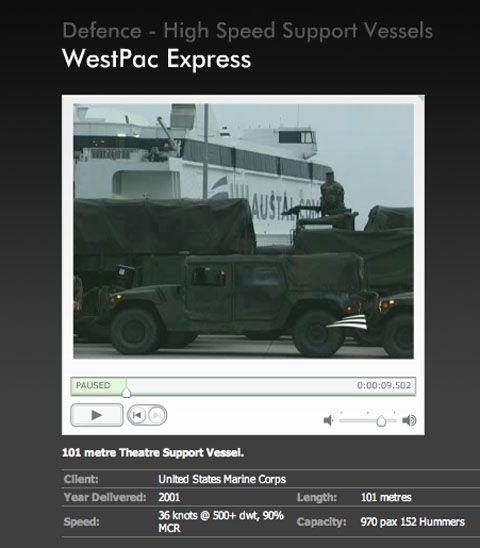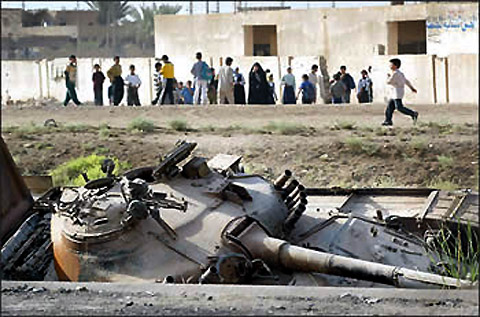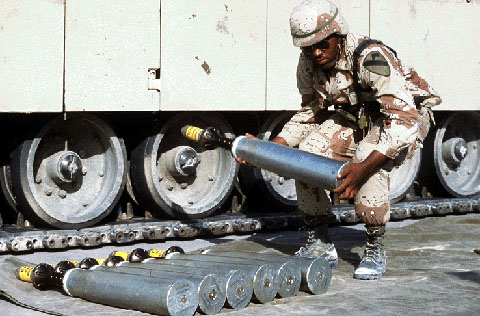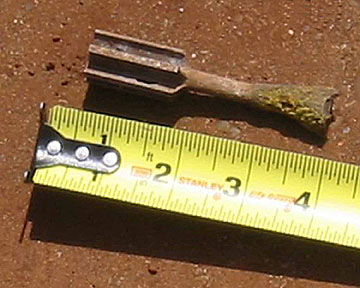www.islandbreath.org ID#0603-20
SUBJECT: MILITARY INTEREST IN HAWAII SUPERFERRY
SOURCE: JUAN WILSON juanwilson@mac.com
POSTED 13 OCTOBER 2006 - 2:00pm HST
Superferry & US Military

movie on autsral.com, manufacturer of Superferry. showing military use. Click image to play.
Visit www.Austal.com for more details about Westpac Express use by the military
by Juan Wilson on 13 October 2006 The Director of Hawaiian Department of Transportation wrote an article in The Garden Island News about the Superferry and all the hurdles it has had to go through in order to come on line. Read it here..
 An Iraqi tank destroyed by a DU shell along the highway next to a school on the outskirts of Baghdad |
SUBJECT: MILITARY INTEREST IN HAWAII SUPERFERRY
SOURCE: JUAN WILSON juanwilson@mac.com
POSTED: 6 OCTOBER 2006 - 3:30pm HST
Stop Military carrying DU Munitions to outer islands!

US Marine core M113 APC's waits for other equipment to load onto West-Pac Express (HSF clone)
The M113A1 Ultra can use Depleted Uranium munitions in 25 mm Bushmaster machine guns.
The military is the Superferry The Hawaii Superferry
is designed to military specifications for moving Light Armored Vehicles
(LAV) , like the Stryker's and M113s, as well as helicopters and most
of the rest of the equipment needed by assault troops like US Army
and Marines forces. After being fired in practice, or the battlefield, DU munitions distribute a fine dust of toxic radioactive material around their impact point. This radioactive dust is Uranium-238 with a half-life of 4.5 billion years. This radioactive dust gets in the soil and gets airborn. Despite denials, the US military has used these munitions in Hawaii and plans to continue using them. The Superferry board is led by Ronald Reagan's Secretary of the Navy, John Lehman, and several of his cronies. They have invested money in the HSF holding company and stand to make a great deal of money with it's operation. The use of the Hawaiian Superferry by the military is a direct threat to the environment and the health of Hawaiians. It is ironic that the people of Hawaii are footing the bill and covering the risk for much of the infrastructure improvements that are required to bring these dreadful weapons to our islands. The articles below are more background material supporting the case that the Superferry is a dangerous military program being foisted on Hawaiians "for their own good". It is time for
a ban on the transportation of toxic radioactive materials on civilian
ferrys before it is begun. You can help by making your voice heard. |
Stryker
Teams Train With New Vehicles [Editor's
note: The 105mm cannon and the 25mm Bushmaster machine gun are both
standard weapons on Stryker vehicle configurations. Both can be equipped
with Depleted Uranium munitions] |
Uranium
revelation upsets isle activists
[Editor's
note: It is our understanding that research into use of these weapons
did not bear fruit until the 1970's] |

US soldier loading 105mm DU round into Bradley vehicle
|
See also:
Island Breath: Superferry & Military
Island Breath: Superferry
Meetings
Island Breath: Superferry Redux
Island
Breath: Superferry Problems
Contact:
Kauai County
Government
Email all Kauai County Council members at:
cokcouncil@kauai.hawaii.gov
Hawaii State Government:
State of Hawaii
Executive Branch:
Governor Linda Lingle
Executive Chambers
State Capitol
Honolulu HI 96813
gov@hawaii.gov
Lt. Gov. James R. Aiona Jr
ltgov@hawaii.gov
Hawaii State
Senate: 7th Senatorial District--Kauai and Niihau
State Senator Gary L. Hooser
Hawaii State Capitol Room 208
415 South Beretania Street
Honolulu HI 96813
Phone: 808-586-6030
Fax: 808-586-6031
From Kauai, toll free 274-3141 + 66030
senhooser@capitol.hawaii.gov
US Federal Government:
US House of Representatives: Hawaii, 1st District
Niel Abercrombie
Honolulu Office
Prince Kuhio Federal Building
300 Ala Moana Blvd.
Room 4-104
Honolulu, HI 96850
phone: (808) 541-2570 fax: (808) 533-0133
Washington Office
1502 Longworth House Office Building
Washington, D.C. 20515
phone: (202) 225-2726 fax: (202) 225-4580
Neil.Abercrombie@mail.house.gov
US House
of Representatives: Hawaii,
2nd District
Ed Case
Honolulu
Office
5104 Prince Kuhio Federal Bldg
Honolulu HI 96850
Phone: 808-541-1986
Fax: 808-538-0233
Washington
DC Office
128 Cannon HOB
Washington DC 20515
Phone: 202-225-4906
Fax: 202-225-4987
ed.case@mail.house.gov
US Senator
from Hawaii:
Senator Daniel Akaka
Honolulu Office
Prince
Kuhio Federal Building
300 Ala Moana Blvd., Rm. 3-106
Box 50144
Washington Office
Honolulu, HI 96850
141 Hart Senate Office Building
Washington DC 20510
Phone: 202-224-6361
senator@akaka.senate.gov
US Senator from Hawaii:
Senator Daniel Inouye
Honolulu Office
Prince Kuhio Federal Building
300 Ala Moana Blvd., Rm. 7-212
Honolulu HI 96850
Washington Office
722 Hart Senate Office Building
Washington, DC 20510
Phone: 202-224-3934
senator@inouye.senate.gov
President
of the United States
George W. Bush
The White House
1600 Pennsylvania Ave., NW
Washington DC 20500
Phone: 202-456-1414
Fax: 202-456-2461
president@whitehouse.gov
Pau
